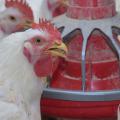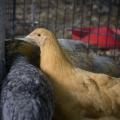Space needs of Bobwhite Quail
The amount of floor space required to produce quality birds depends on many factors including species of bird, age of bird, type of bird being produced, quality of management, etc. In regards to bobwhite quail requirements, meat- type and flight birds will be discussed separately.
Meat-type bobwhite quail do not require as much floor area as other types of quail even though they are, as a rule, larger birds. The restriction of space may be an asset in some cases because increased movement and exercise are detrimental to rapid weight gains. Excess floor space encourages increased movement and exercise. The only disadvantage is the increased potential for cannibalism and pecking. Dietary changes, decreased lighting, and debeaking will help reduce the cannibalism danger.
Meat-type bobwhite quail do not require extra floor space because the quality of feathers is not a high priority concern. When starting day-old chicks, allow about 1 square foot of floor space for every 10 chicks through the first 2 weeks. During the 4-6 week period the birds need at least .25 square foot per bird and at 6-12 weeks of age the birds need at least .75 square foot per bird.
Flight birds are provided at least .1 square foot per bird during the first 2 weeks, followed with .25 square foot for each 4-6 week old bird. When birds are placed in flight pens, each bird must be allowed at least 2 square feet until its release on a shooting preserve. The extra space allows the development of good plumages.
Bobwhite quail intended as breeders are brooded through 12 weeks of age with the same space allotments as meat-type birds. They are provided a minimum of 1 square foot per bird during the period of 12 weeks of age and their placement in the breeder pens. Bobwhite quail breeding pens should provide at least 2 square feet for each breeder bird, regardless of sex or bird type.
The floor space allocations stated above are for game birds produced during the moderate and cool seasons of the year and when no unusual disease factors are present. If the temperatures frequently exceed 90º F. the space allotments should be increased by 25 percent. This increase helps reduce cannibalism and heat stress in the flock. If cannibalism becomes a problem, debeaking while increasing the floor space allowance will greatly help in correcting the vice.
Publications
News
STARKVILLE, Miss. -- Until an avian flu vaccine for chickens or other alternative is federally approved, commercial poultry operations in the U.S.
STARKVILLE, Miss. -- If egg prices have seemed higher than ever lately, it’s because they are, and consumers can place much of the blame squarely at the feet of the ongoing bird flu outbreak.
With highly pathogenic avian influenza, or HPAI, in the environment in Mississippi, owners of backyard flocks have to take extra steps to keep their chickens healthy.
Avian influenza poses an extremely low risk to human health and none to food safety in Mississippi, but its presence poses a risk to backyard flocks and the state’s $3 billion commercial poultry industry.







